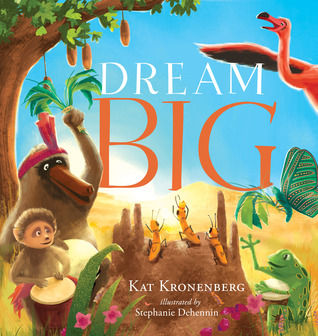
There are a couple of different ways I look at and rate children’s picture books. Is it pretty to look at? Is the story simple and yet captivating for the child? Is there an important message for the child? What is the re-readability (will children want to have it read over and over and perhaps more importantly – will parents mind reading it again and again [and if you don’t think that’s important then you’ve never hidden a book away that you just don’t want to read again!]).
Dream Big, as the title suggests, is about not limiting your dreams. You can be whatever you want to be. And perhaps there’s no better lesson for a child. Let’s let them know early on that the sky’s the limit.
Is the story simple and captivating for a child. Most definitely yes. The book uses repetition to help build interest and clarity in the story. Repetition is one of the key components for writing a children’s book. And the words are simple, making it easy for the youngest of children to listen and grow into the book.
The art is colorful and bright. The style is not my personal favorite. It borders on, but falls short of realism. It is not ‘real’ in the sense of Chris van Allsburg or Jan Brett, but it’s also not uniquely stylized either. These are realistic animals with a slightly anthropomorphized appearance in a slightly flat art scheme.
The message that is being shared here in the story is … well … a little confusing at best. On the surface, it’s a great message – dream big because you can be whatever you want to be. But the underlying message is less robust. A caterpillar wants to be able to fly. A tadpole wants to be able to jump. A young bird wants to be beautiful. Each gets laughed at by the baboon and each sees his/her wish come true. The caterpillar becomes a butterfly. The tadpole becomes a frog. The young bird becomes a pretty pink flamingo.
First, the dreams of these critters (other than the caterpillar) don’t seem to be too far out there. To jump? To be pretty? Can we not exercise our brains just a little more and wish a littler harder for something even more unique? But this is for the youngest of children who don’t have much life experience, so that’s okay.
But how about wishing for something that can happen with effort to make the dreams come true? Is simply wishing enough? It appears to be so. And what’s more, these creatures only wish for something that is going to occur to them whether they wish for it or not. Even though the sky lights up in this book, proclaiming through the stars that “You can do anything” and “you can have anything” that’s not the message we’re really getting (even though it’s a good message!). We’re getting the message that ‘you’re going to change as you grow’ (which is okay, too).
So how about the re-reading factor? The language is simple but it struggles to find a rhythm. Sometimes it feels like it’s trying so hard to rhyme and when I read it I’m wanting to build in to a nice cadence, but then something trips me up. An added sentence to help the story but not the out-loud reading of the story. I could re-read this to young ones on more than one occasion (though not easily), but once they start asking questions about the animals changing I think it would be time to stop.
Looking for a good book? Dream Big by Kat Kronenberg does itself dream big with a hefty, important message for children, but it just doesn’t completely satisfy.
I received a digital copy of this book from the publisher, through Netgalley, in exchange for an honest review.
* * * * * *
Dream Big
author: Kat Kronenberg
artist: Kat Kronenberg
publisher: Greenleaf Book Group Press
ISBN: 1626343470
hardcover, 48 pages






